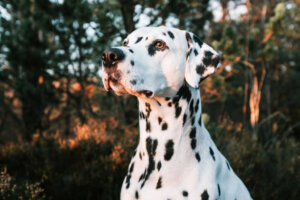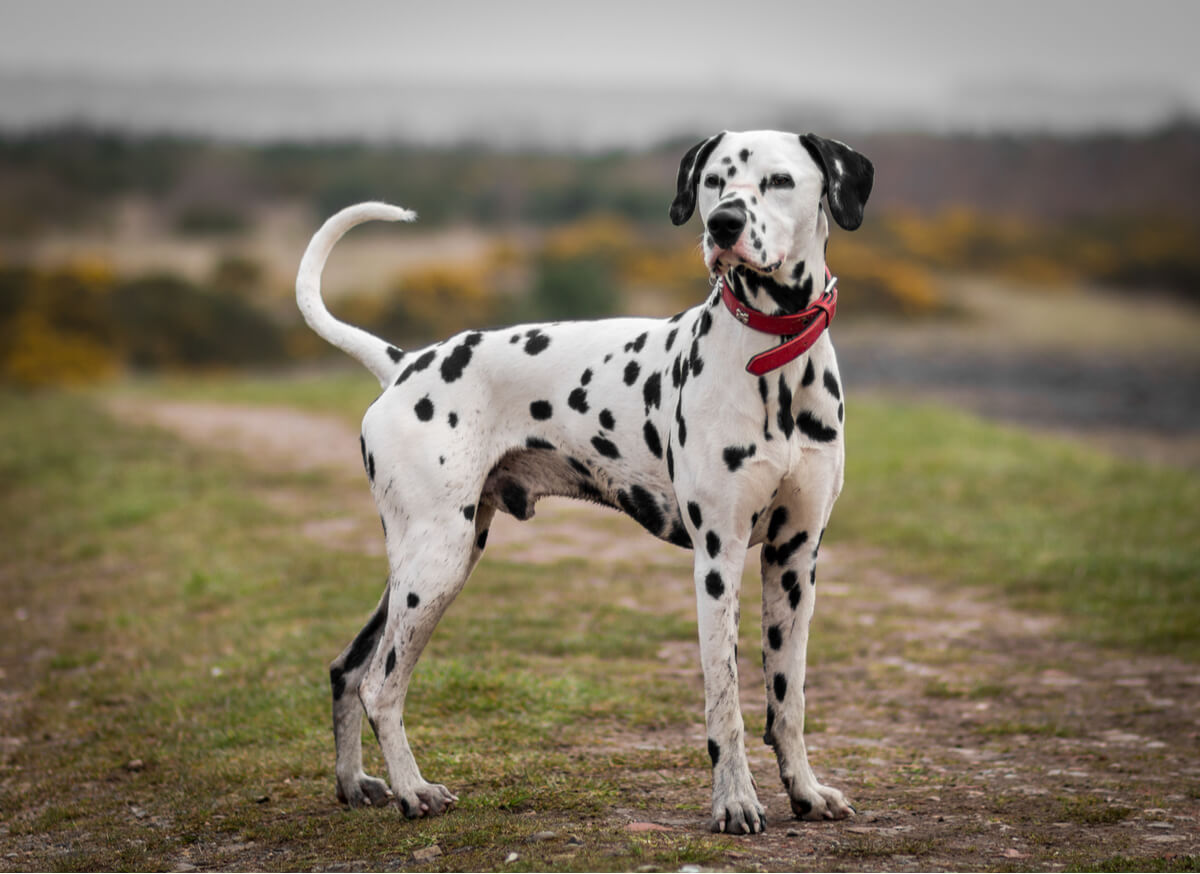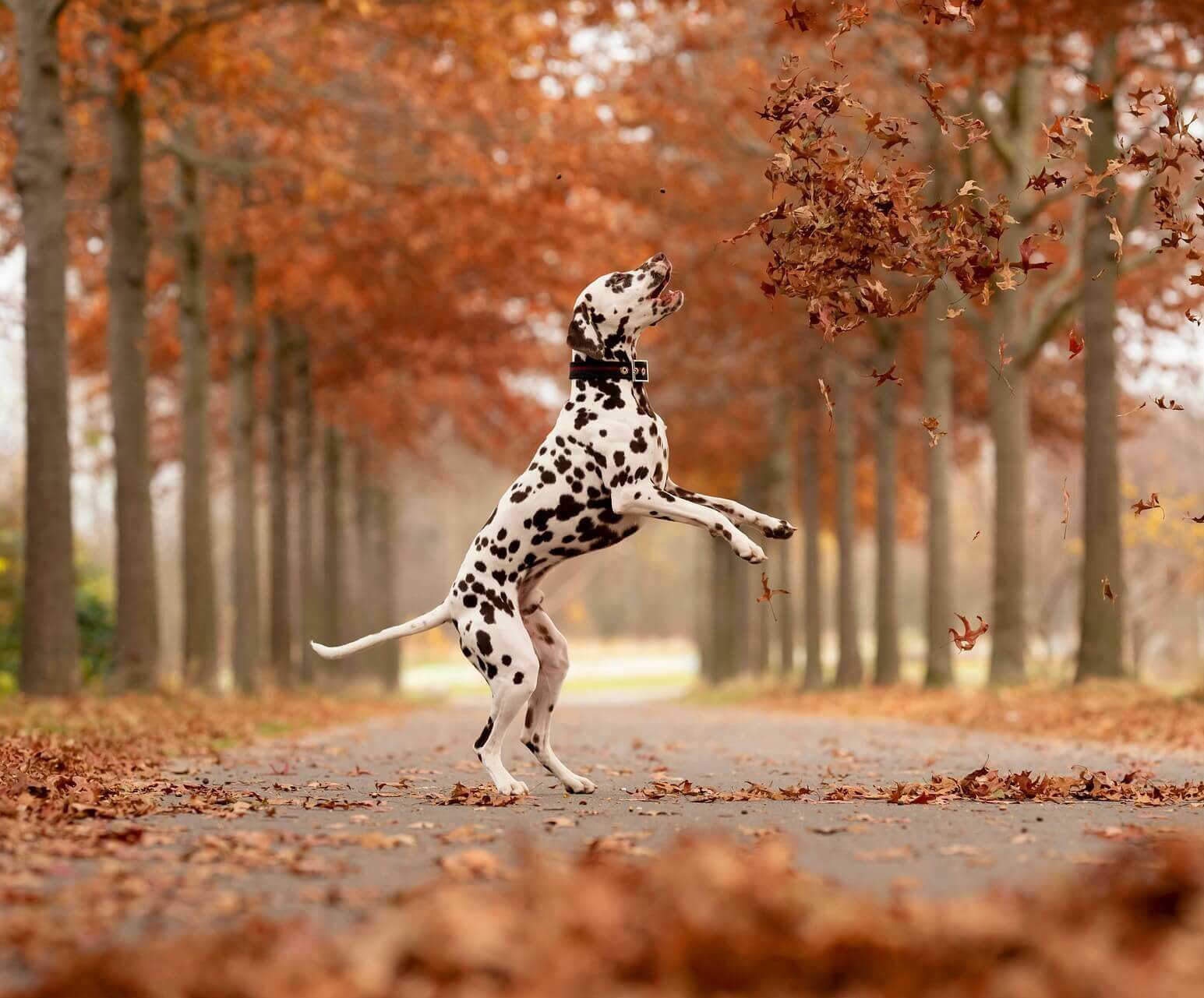Dalmatians: Are They Really Fire Dogs?

A Dalmatian in a firefighter’s helmet is a familiar image to many. Illustrations and children’s programs have been showing us this association for years, but have you ever seen one of these dogs accompanying firefighters? It seems far-fetched, considering the great danger they would be in in a fire. Find out about why Dalmatians are fire dogs in today’s fascinating article.
Maybe you weren’t aware that the history of firefighting Dalmatians goes back centuries. Here you can find out how this image has persisted to the present day, so don’t miss it.
Dalmatian characteristics

Dalmatians are large dogs, reaching up to 35 kilograms (77 pounds) in weight and over half a meter (1.6 feet) in height. Their characteristic droopy ears and black markings are its most striking features. They have a slender, muscular body, as well as a short, soft coat that must be brushed often during molting season.
At birth, Dalmatians are totally white; their spots don’t appear until they’re about 2 weeks old.
They’re a very energetic breed, eager to play and, in addition, they have a sensitive character. They learn easily, so training is easy as long as it’s done from a positive perspective and is constant.
In addition, Dalmatians create a strong bond with all the members of their family. In fact, without proper training they may become overprotective and distrustful of strangers. This is also due to their innate shyness.
History of the Dalmatian
The earliest records date back to the 16th century, in paintings and church chronicles from the town of Veli Lošinj in Croatia. Although its name comes from Dalmatia, another region of the same country, it seems that this dog began to be bred throughout the eastern region of the Mediterranean basin.
Between the 16th and 18th centuries, this dog went unnoticed outside its region of origin, being reserved for guard and escort work. However, as early as 1790, British documents refer to it as a “carriage dog”. It wasn’t until 1955 that the Dalmatian was accepted as an official breed in the FCI.
Why are Dalmatians considered to be fire dogs?
To understand why Dalmatians are considered to be fire dogs, we need to go back to the fact we mentioned above: during the 19th century they were used as carriage dogs. A carriage dog was a dog that trotted alongside horse-drawn carriages and whose mission was to escort the horses throughout the journey.
In this way, Dalmatians prevented them from running off due to fright, and possibly overturning the carriage or causing it to veer out of control. They also offered protection from muggers and other dangers that might lurk along the roads.
Dalmatians have great physical endurance, which made them able to withstand long walks alongside the carriages.
Just as they were adapted to carriages carrying people, they were also adapted to protect the horse-drawn fire engines of the time. The dogs were able to run in front of them, making their way through the streets and alerting the population to stay away.
Over time, English firefighters recognized the incredible work of these dogs during emergencies. Even when motorized fire trucks were introduced, these professionals still carried Dalmatians in the cab for years.
The evolution of Dalmatian fire dogs

There came a point in history when the Dalmatian ceased to be useful in its role as a firefighter. As with all animals that humans stopped using in different areas, they were abandoned. Fortunately, its beautiful appearance and affectionate nature earned it a place in British households, and it then became a sign of distinction in high society.
There are now several breeds used by rescue professionals, such as German Shepherds and Border Collies.
At the end of the 20th century, the demand for this breed skyrocketed due to its starring role in the Disney movie, 101 Dalmatians, which led to thousands of subsequent abandonments and mass breeding that ended up affecting the health of these dogs.
These day, this situation has been regulated, but purebred Dalmatians still retain a tendency to suffer from deafness and kidney problems.
These days, Dalmatians are is kept as companion animals. However, they continue to be used in different areas, such as beauty contests and farm guarding.
We’d like to highlight the fact that these dogs are increasingly appreciated and adopted for what they are: a faithful, affectionate animal which will reward their owner with love, especially when you take them out for a walk – a truly rewarding experience!
Fortunately, awareness about their needs and rights is becoming more and more widespread.
A Dalmatian in a firefighter’s helmet is a familiar image to many. Illustrations and children’s programs have been showing us this association for years, but have you ever seen one of these dogs accompanying firefighters? It seems far-fetched, considering the great danger they would be in in a fire. Find out about why Dalmatians are fire dogs in today’s fascinating article.
Maybe you weren’t aware that the history of firefighting Dalmatians goes back centuries. Here you can find out how this image has persisted to the present day, so don’t miss it.
Dalmatian characteristics

Dalmatians are large dogs, reaching up to 35 kilograms (77 pounds) in weight and over half a meter (1.6 feet) in height. Their characteristic droopy ears and black markings are its most striking features. They have a slender, muscular body, as well as a short, soft coat that must be brushed often during molting season.
At birth, Dalmatians are totally white; their spots don’t appear until they’re about 2 weeks old.
They’re a very energetic breed, eager to play and, in addition, they have a sensitive character. They learn easily, so training is easy as long as it’s done from a positive perspective and is constant.
In addition, Dalmatians create a strong bond with all the members of their family. In fact, without proper training they may become overprotective and distrustful of strangers. This is also due to their innate shyness.
History of the Dalmatian
The earliest records date back to the 16th century, in paintings and church chronicles from the town of Veli Lošinj in Croatia. Although its name comes from Dalmatia, another region of the same country, it seems that this dog began to be bred throughout the eastern region of the Mediterranean basin.
Between the 16th and 18th centuries, this dog went unnoticed outside its region of origin, being reserved for guard and escort work. However, as early as 1790, British documents refer to it as a “carriage dog”. It wasn’t until 1955 that the Dalmatian was accepted as an official breed in the FCI.
Why are Dalmatians considered to be fire dogs?
To understand why Dalmatians are considered to be fire dogs, we need to go back to the fact we mentioned above: during the 19th century they were used as carriage dogs. A carriage dog was a dog that trotted alongside horse-drawn carriages and whose mission was to escort the horses throughout the journey.
In this way, Dalmatians prevented them from running off due to fright, and possibly overturning the carriage or causing it to veer out of control. They also offered protection from muggers and other dangers that might lurk along the roads.
Dalmatians have great physical endurance, which made them able to withstand long walks alongside the carriages.
Just as they were adapted to carriages carrying people, they were also adapted to protect the horse-drawn fire engines of the time. The dogs were able to run in front of them, making their way through the streets and alerting the population to stay away.
Over time, English firefighters recognized the incredible work of these dogs during emergencies. Even when motorized fire trucks were introduced, these professionals still carried Dalmatians in the cab for years.
The evolution of Dalmatian fire dogs

There came a point in history when the Dalmatian ceased to be useful in its role as a firefighter. As with all animals that humans stopped using in different areas, they were abandoned. Fortunately, its beautiful appearance and affectionate nature earned it a place in British households, and it then became a sign of distinction in high society.
There are now several breeds used by rescue professionals, such as German Shepherds and Border Collies.
At the end of the 20th century, the demand for this breed skyrocketed due to its starring role in the Disney movie, 101 Dalmatians, which led to thousands of subsequent abandonments and mass breeding that ended up affecting the health of these dogs.
These day, this situation has been regulated, but purebred Dalmatians still retain a tendency to suffer from deafness and kidney problems.
These days, Dalmatians are is kept as companion animals. However, they continue to be used in different areas, such as beauty contests and farm guarding.
We’d like to highlight the fact that these dogs are increasingly appreciated and adopted for what they are: a faithful, affectionate animal which will reward their owner with love, especially when you take them out for a walk – a truly rewarding experience!
Fortunately, awareness about their needs and rights is becoming more and more widespread.
All cited sources were thoroughly reviewed by our team to ensure their quality, reliability, currency, and validity. The bibliography of this article was considered reliable and of academic or scientific accuracy.
- Hayward, J. J., Kelly-Smith, M., Boyko, A. R., Burmeister, L., De Risio, L., Mellersh, C., … & Strain, G. M. (2020). A genome-wide association study of deafness in three canine breeds. PLoS One, 15(5), e0232900.
- DALMATINSKI PAS. (s. f.). FCI. Recuperado 9 de marzo de 2022, de http://www.fci.be/es/nomenclature/DALMATA-153.html
This text is provided for informational purposes only and does not replace consultation with a professional. If in doubt, consult your specialist.








